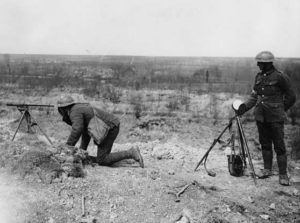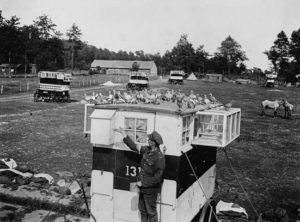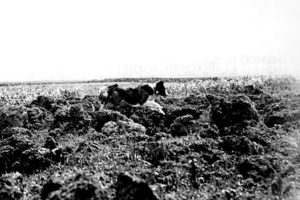Communications in WWI
Effective and timely communications were a constant challenge in the Great War. The consequences of poor communications ran the gamut from operational inefficiencies to catastrophic lose of life. During an offensive, the failure of timely communication could be grave. There are numerous soldiers’ letters and books that report the hard-won capture of an enemy position, lost almost immediately because the command post didn’t know what had happened and therefore didn’t send reinforcements.
Emerging Technology
The ‘high tech’ solution of WWI was the wireless radio. Although it had been around for some time, by 1914 it was not really ready for war use. The sets weren’t very mobile, secure or durable. They were large and unwieldy. Furthermore, their messages were too easily intercepted by the opposition to be useable without cyphers. Even when they became more portable during the later war years, their reliability remained poor.
The wireless telegraph was used successfully over long distances by navies on both sides, ironically because the equipment itself was not required to be portable either at the land bases or at sea.
By contrast, armies were forced to rely upon physical wires to connect both the telegraph and the field telephone. Unless the wires were buried very deeply, they was vulnerable to enemy artillery. While they worked reasonably well behind the lines, they were less useful on the front. Taking the time to bury the wire was impossible when the column was on the move. Some terrains, such as that of Salonika, were just too rocky.
Traditional Communications

Other low-tech solutions were much used but also had drawbacks. Flares were useful but needed a pre-agreed and simple meaning. Semaphore was confined to daylight hours, required good visibility and could be intercepted if seen by the enemy. Heliographs (a solar telegraph using mirrors) had several advantages including their ability to transmit securely over very long distances using mobile equipment that did not require any power source. However heliographs need sunlight to reflect off their mirrors and were most useful in the theatres of the Middle East and Africa.
Feathered Friends
Homing pigeons are a proven communications resource and have been used for thousands of years. They were used in Ancient Greece to communicate the results of the Olympics; Paul Reuter, the founder of the eponymous news agency, used them to supplement the telegraph in the 1860s; and police units in remote areas of India used them until the early 2000s.¹
Both their value and danger were immediately recognized when war broke out in 1914. The Alien Registration Act of August 1914 prohibited foreign nationals from having weapons, radio transmitters and homing pigeons without the prior agreement of the Chief Constable. This legislation resulted in a flurry of prosecutions, including several registered aliens who were sent to jail for up to six months for keeping homing pigeons without this authority.²
The shooting of homing pigeons became a serious offence, ameliorated slightly if the dead pigeons and their messages were immediately handed in. In September 1914, the Birmingham and Midland Federation of Homing Pigeon Societies, which had over 2,000 members, offered 30,000 birds to support the war effort. In May 1918, the British Government had welcomed, from pigeon-breeders of Australia, the offer of 2,000 young homing pigeons.³

Despite their one limitation – which was that they could find their way home but not back again – over 100,000 homing pigeons were used in WWI. They accompanied troops to the front line and airmen on their reconnaissance and bombing missions. They also sailed with ships of the Royal Navy and the merchant marine. Their ability to deliver messages over hundreds of miles helped to achieve military objectives and save countless lives. They could comfortably fly 50 miles an hour and, rather horrifically, were more difficult to shoot than a courier. Several were decorated for their war efforts, many with great fanfare, others more low key:

Four-Legged Friends

Dogs were used for many roles throughout WWI. They ranged from mascots and companions, to rat catchers, signallers of danger and aid dogs carrying first aid kits into no-mans land. Some, as shown in this photograph, were also communication dogs – successfully running back and forward with messages.
References & further reading
¹ Homing Pigeons Wikipedia
² ³ various articles in the Manchester Guardian newspaper from 1914 to 1918
* image may be subject to copyright
^ clipping from the Guardian, copyright 2017 Newspaper.com
** from Field Marshall (Earl) Haig’s papers in the National Library of Scotland
Military Communications by Back & Thompson in Britannica
Telecommunications in Wall Street Journal
The Western Front’s dogs of war in Telegraph
The WWI pigeons who earned their wings in Telegraph

